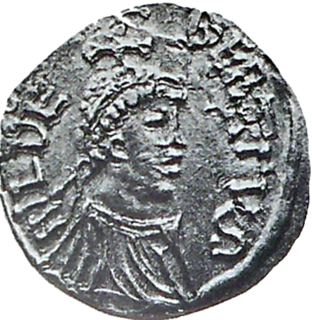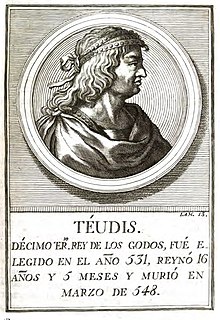
Amalaric was king of the Visigoths from 522 until his death in battle in 531. He was a son of king Alaric II and his first wife Theodegotha, daughter of Theoderic the Great.

Alaric II was the King of the Visigoths from 484 until 507. He succeeded his father Euric as king of the Visigoths in Toulouse on 28 December 484; he was the great-grandson of the more famous Alaric I, who sacked Rome in 410. He established his capital at Aire-sur-l'Adour in Aquitaine. His dominions included not only the majority of Hispania but also Gallia Aquitania and the greater part of an as-yet undivided Gallia Narbonensis.
The 530s decade ran from January 1, 530, to December 31, 539.
The 500s decade ran from January 1, 500, to December 31, 509.
The 520s decade ran from January 1, 520, to December 31, 529.
The 540s decade ran from January 1, 540, to December 31, 549.
The 550s decade ran from January 1, 550, to December 31, 559.
The 580s decade ran from January 1, 580, to December 31, 589.

Year 496 (CDXCVI) was a leap year starting on Monday of the Julian calendar. In the Roman Empire, it was known as the Year of the Consulship of Paulus without colleague. The denomination 496 for this year has been used since the early medieval period, when the Anno Domini calendar era became the prevalent method in Europe for naming years.

Year 507 (DVII) was a common year starting on Monday of the Julian calendar. At the time, it was known as the Year of the Consulship of Anastasius and Venantius. The denomination 507 for this year has been used since the early medieval period, when the Anno Domini calendar era became the prevalent method in Europe for naming years.

Year 511 (DXI) was a common year starting on Saturday of the Julian calendar. At the time, it was known as the Year of the Consulship of Felix and Secundinus. The denomination 511 for this year has been used since the early medieval period, when the Anno Domini calendar era became the prevalent method in Europe for naming years.

Year 532 (DXXXII) was a leap year starting on Thursday of the Julian calendar. At the time, it was known as the Second year after the Consulship of Lampadius and Probus. The denomination 532 for this year has been used since the early medieval period, when the Anno Domini calendar era became the prevalent method in Europe for naming years.

Year 534 (DXXXIV) was a common year starting on Sunday of the Julian calendar. At the time, it was known as the Year of the Consulship of Iustinianus and Paulinus. The denomination 534 for this year has been used since the early medieval period, when the Anno Domini calendar era became the prevalent method in Europe for naming years.

Year 502 (DII) was a common year starting on Tuesday of the Julian calendar. At the time, it was known as the Year of the Consulship of Avienus and Probus. The denomination 502 for this year has been used since the early medieval period, when the Anno Domini calendar era became the prevalent method in Europe for naming years.

Clotilde, also known as Clothilde, Clotilda, Clotild, Rotilde etc., was a Queen of All the Franks. She was supposedly descended from the Gothic king Athanaric and became the second wife of the Frankish king Clovis I in 493. The Merovingian dynasty to which her husband belonged ruled Frankish kingdoms for over 200 years (450–758).

Chlothar I was a king of the Franks of the Merovingian dynasty and one of the four sons of Clovis I.

Childebert I was a Frankish King of the Merovingian dynasty, as third of the four sons of Clovis I who shared the kingdom of the Franks upon their father's death in 511. He was one of the sons of Saint Clotilda, born at Reims. He reigned as King of Paris from 511 to 558 and Orléans from 524 to 558.

Theudis, was king of the Visigoths in Hispania from 531 to 548.

Liuva I was a Visigothic King of Hispania and Septimania.
Clotilde was the daughter of King Clovis I of the Franks and Queen Clotilde and the queen of the Visigothic King Amalaric. She was born circa 500. The favorite child of her parents, she was saddened by her father's death in 511.













